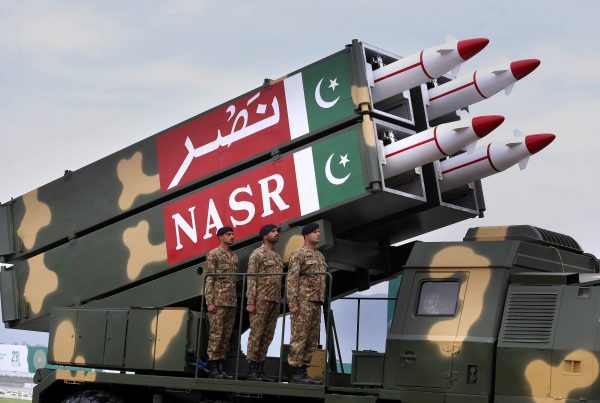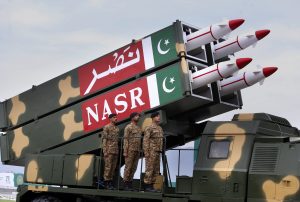space cadet
SENIOR MEMBER

The China-Pakistan Nuclear Nexus: How Can India Respond?
Pakistan has been rapidly advancing its nuclear weapons capabilities with China’s help. What can India do about it?
thediplomat.com
The China-Pakistan Nuclear Nexus: How Can India Respond?
Pakistan has been rapidly advancing its nuclear weapons capabilities with China’s help. What can India do about it?
By Sanjana Gogna and Nasima Khatoon
March 27, 2020

A Pakistani-made ballistic missile NASR is loaded on a trailer during a military parade to mark Pakistan National Day, in Islamabad, Pakistan, March 23, 2019.
Credit: AP Photo/Anjum NaveedADVERTISEMENT
Indian custom officers detained the Chinese ship Dai Cui Yun, bound to Karachi, at Gujarat’s Kandla port in February this year for misdeclaring an item, namely an autoclave that falls under India’s “Dual-Use Export Control” list. The autoclave was seized, and after examinations the Indian government confirmed earlier this month that the device has military applications. Autoclaves are used to manufacture sheets of silica, which can be used to line solid-fuel ballistic missiles to allow them to withstand high temperatures and pressure during a missile launch.
Both China and Pakistan are India’s strategic adversaries. China has a long history of transferring nuclear weapon technology and material to Pakistan starting in the 1980s, through which it has assisted Islamabad to develop its nuclear deterrent against India. For instance, it has been established that China passed the entire design for a nuclear weapon to Pakistan in the early 1980s. Such a transfer was extraordinary, as no other country has ever handed over the full design for a nuclear weapon to a strategic partner. (The same designs were later passed to Libya through the illicit proliferation network established by A.Q. Khan, the founder of Pakistan’s uranium enrichment program.) In the early 1980s, China also provided Pakistan with weapon-grade uranium that could power two nuclear devices. Further, in 1988 China sold components of its M-11 short-range ballistic missiles to Pakistan, which the latter has used to develop nuclear-capable missiles.
In order to curtail its nuclear proliferation, the United States levied several sanctions on China throughout the 1990s. The sanctions were rolled back when China, albeit a nonmember, assured that it would follow the Missile Technology Control Regime (MTCR) guidelines, which seek to limit the proliferation of missiles and missile technology. However, China continues to transfer nuclear weapons technology to Pakistan through a narrow interpretation of the guidelines. In a similar manner, China has also contravened its Nuclear Suppliers Group (NSG) obligations since it became a member in 2004 by developing nuclear reactors in Karachi.
The incident at Kandla port signals that Chinese assistance to Pakistan remains a cause of concern for India, as Islamabad has been rapidly advancing its nuclear weapons capabilities with China’s help. Of late, Pakistan has introduced several new nuclear-capable missile systems such as the solid-fuel ballistic missile Shaheen III, which has a range of 2,750 km. Experts have identified significant similarities between the designs of Shaheen missiles and China’s DF-11. Plus, in March 2018, the Defense Intelligence Agency of the United States confirmed that Pakistan had conducted tests of a Multiple Independent Reentry Vehicles (MIRV) capable missile, Ababeel. MIRV capability allows a ballistic missile to send several separately targeted nuclear warheads on their separate ways. China later confirmed its assistance to Pakistan in developing MIRV capabilities, which included the sale of a highly sophisticated, large-scale optical tracking and measurement system.
The Indian government, in addition to seizing the autoclave aboard the Dai Cui Yun as per domestic legal procedures, has conveyed its concern to the Chinese side; both actions demonstrate India’s proactive stand against China’s nuclear proliferation. However, it is crucial for India to use other diplomatic options to counter the China-Pakistan nuclear nexus. As an MTCR member, India can raise this matter at its meetings to generate global pressure on China to adhere to the guidelines and make China’s membership to the regime conditional on its cessation of such nuclear transfers. Similarly, India also needs to use other relevant international forums such as the Wassenaar Arrangement and the Conference on Disarmament to expose and curtail such transfers. More importantly, India needs to open discussions on the China-Pakistan nuclear nexus in its parliament so that public knowledge on this issue can be generated and sustained diplomatic action can be taken.
